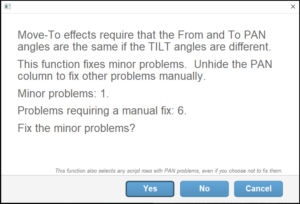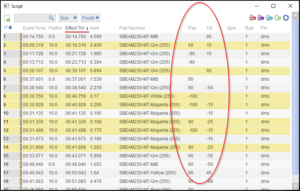Move-To effects for moving head DMX fixtures animate the PAN and TILT angles of the moving head, interpolating from the dotted line trajectory angle of the previous effect to the dotted line trajectory angle of the Move-To effect. The animation will be smooth if the interpolation involves changing PAN or TILT, but in general the animation will not be smooth if the interpolation involves both PAN and TILT moving simultaneously. Move-To effects that would animate both PAN and TILT are usually errors.
The function, “DMX > Detect and fix PAN problems with Move-To effects” identifies these likely errors, and automatically fixes a class of minor errors that occur frequently while designing. The function displays the dialog shown in Figure 1, indicating the number of minor, fixable errors, and the number of other errors that you would have to fix manually.

Figure 1 – The function can fix minor problems automatically; it highlights other problems so you can fix them manually.
Figure 2 shows the script that yields the dialog of Figure 1. The yellow rows represent the problems, of which one is a minor, fixable problem, and the other six require manual fixes. In this example, you can see that all the yellow rows have different PAN and TILT values from rows above them. Those are the seven likely errors that the dialog refers to.

Figure 2 – Look at the PAN and TILT of consecutive rows. If a Move-To event has a different PAN and TILT from the previous row, it is probably an error.
The part numbers in this script contain “MT” if they are Move-To events. They contain “MIB” if they are Move-In-Black events. By quick inspection, you can confirm that the yellow rows are Move-To events that would animate the PAN and TILT angles.
Minor, fixable errors
Row #8 is the only yellow row that has a blank (zero) TILT value. That is what makes it a minor, fixable error instead of an error that requires manual fixing. TILT of zero is special because when tilt is zero, the head is aiming straight up. When the head is aiming straight up, you can’t tell the difference between PAN values by looking at the beam (ignoring the inconsequential exception of beams with gobos). The PAN values just spin the beam on its axis.
Since the PAN value can be anything when the TILT is zero, problems like row #8 can be fixed by simply changing the PAN value to match the PAN value of the previous row or next row. That’s exactly what this function does if you choose to fix the minor problems.
Problems that require manual fixes
The other yellow rows animating both the PAN and TILT angles cannot be fixed so easily. Consider row #2, for example. It is a Move-To that changes both PAN and TILT from the row above it, row #1. Since TILT of row #1 and row #2 are both non-zero, neither PAN can be changed without changing the appearance of the beams. For problems like this, the function doesn’t attempt a fix since there is no way for it to know what you want. If the problem is indeed an error, then you should change one of the PAN or TILT values to eliminate the error, or introduce an additional Move-To in between the two rows as an intermediate “knee” that divides that animation into two steps, one that animates the PAN and the other that animates the TILT.
